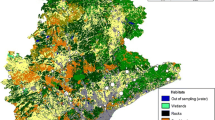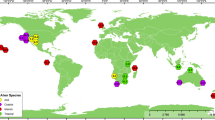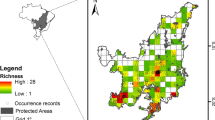Abstract
Biological invasions and changes in land-use are two components of global change affecting biodiversity worldwide. There is overriding evidence that invasions can dramatically change the landscape and that particular land-use types facilitate invasions. Still, these issues have not formally percolated into risk analysis of biological invasions, and only recently has the influence of the surrounding landscape on invasive species spread started to be considered. In this paper we review the literature on the influence of the surrounding landscape on the local level of plant invasions (i.e., abundance and richness of alien plants in plant communities). Our review confirms that there are more alien plant species and they are more abundant at fragment edges than in the interior of fragments. The decline on the level of invasion towards the interior of fragments is sharp. To a lesser extent, there is higher invasion in small isolated fragments than in large connected patches. However, despite their relevance, the influence of connectivity and shape of the fragments have been scarcely explored. Besides the fact that a site has more invaders if surrounded by a human-dominated landscape than by a natural one, the past history and the configuration of that landscape are also important. Invasion within land-uses is often associated with the historical legacy of changes in land-use, indicating that current land-uses might represent an invasion credit to future invasions. Accurate accounts of the invasion process and effective conservation programs will depend on such considerations.



Similar content being viewed by others
References
Ahern RG, Landis DA, Reznicek AA, Schemske DW (2010) Spread of exotic plants in the landscape: the role of time, growth habit, and history of invasiveness. Biol Invasions 12:3157–3169
Aragón R, Morales JM (2003) Species composition and invasion in NW Argentinian secondary forests: effects of land use history, environment and landscape. J Veg Sci 14:195–204
Bartuszevige AM, Gorchov DL, Raab L (2006) The relative importance of landscape and community features in the invasion of an exotic shrub in a fragmented landscape. Ecography 29:213–222
Borgmann KL, Rodewald AD (2005) Forest restoration in urbanizing landscapes: interactions between land-uses and exotic shrubs. Restor Ecol 13:334–340
Burls K, McClaugherty C (2008) Landscape position influences the distribution of garlic mustard, an invasive species. Northeast Nat 15:541–556
Chytrý M, Maskel LC, Pino J, Pyšek P, Vilà M, Font X, Smart SM (2008) Habitat invasions by alien plants: a quantitative comparison between Mediterranean, subcontinental and oceanic regions of Europe. J Appl Ecol 45:448–458
Cilliers SS, Williams NSG, Barnard FJ (2008) Patterns of exotic plant invasions in fragmented urban, and rural grasslands across continents. Landscape Ecol 23:1243–1256
Colón SM, Lugo AE (2006) Recovery of a subtropical dry forest after abandonment of different land uses. Biotropica 38:354–364
Cully AC, Cully JF Jr, Hiebert JF (2003) Invasion of exotic plant species in tallgrass prairie fragments. Conserv Biol 17:990–998
D’Antonio CM, Vitousek PM (1992) Biological invasions by exotic species, the gras/fire cycle, and global change. Annu Rev Ecol Evol Syst 23:63–87
Damschen EI, Haddad NM, Orrock JL, Tewksbury JJ, Levey DJ (2006) Corridors increase plant species richness at large scales. Science 313:1284–1286
Davis MA (2009) Invasion biology. Oxford University Press, Oxford
Deckers B, Verheyen K, Vanhellemont M, Maddens E, Muys B, Hermy M (2008) Impact of avian frugivores on dispersal and recruitment of the invasive Prunus serotina in an agricultural landscape. Biol Invasions 10:717–727
DeGasperis BG, Motzkin G (2007) Windows of opportunity: historical and ecological controls on Berberis thunbergii invasions. Ecology 88:3115–3125
Didham RK, Tylianakis JM, Gemmell NJ, Rand TA, Ewers RM (2007) Interactive effects of habitat modification and species invasion on native species decline. Trends Ecol Evol 22:489–496
Domènech R, Vilà M, Pino J, Gesti J (2005) Historical land-use legacy and Cortaderia selloana invasion in the Mediterranean region. Glob Change Biol 11:1054–1064
Ehrenfeld JG (2008) Exotic invasive species in urban wetlands: environmental correlates and implications for wetland management. J Appl Ecol 45:1160–1169
Fahrig L (2003) Effects of habitat fragmentation on biodiversity. Annu Rev Ecol Evol Syst 34:487–515
Fischer J, Lindenmayer DB (2007) Landscape modification and habitat fragmentation: a synthesis. Glob Ecol Biogeogr 16:265–280
Forseth I, Innis A (2004) Kudzu (Pueraria montana): history, physiology, and ecology combined to make a major ecosystem threat. Crit Rev Plant Sci 23:401–413
Gassó N, Sol D, Pino J, Dana ED, Lloret F, Sanz-Elorza M, Sobrino E, Vilá M (2009) Exploring species attributes and site characteristics to assess plant invasions in Spain. Divers Distrib 15:50–58
Gavier-Pizarro GI, Radeloff VC, Stewart SI, Huebner CD, Keuler NS (2010) Housing is positively associated with invasive exotic plant species richness in New England, USA. Ecol Appl 20:1913–1925
Gelbard JL, Belnap J (2003) Roads as conduits for exotic plant invasions in a semiarid landscape. Conserv Biol 17:420–432
Guirado M, Pino J, Rodà F (2006) Understory plant species richness and composition in metropolitan forest archipelagos: effects of forests size, adjacent land-use and distance to the edge. Glob Ecol Biogeogr 15:50–62
Hansen MJ, Clevenger AP (2005) The influence of disturbance and habitat on the presence of non-native plant species along transport corridors. Biol Conserv 125:249–259
Harper KA, Macdonald SE, Burton PJ, Chen J, Brosofske KD, Saunders SC, Euskirchen ES, Roberts D, Jaiteh MS, Esseen PA (2005) Edge influence on forest structure and composition in fragmented landscapes. Conserv Biol 19:768–782
Harrison S (1999) Local and regional diversity in a patchy landscape: native, alien, and endemic herbs on serpentine. Ecology 80:70–80
Helm A, Hanski I, Partel M (2006) Slow response of plant species richness to habitat loss and fragmentation. Ecol Lett 9:72–77
Hierro JL, Maron JL, Callaway RM (2005) A biogeographical approach to plant invasions: the importance of studying exotics in their introduced and native range. J Ecol 93:5–15
Hill SJ, Tung PJ, Leishman MR (2005) Relationships between anthropogenic disturbance, soil properties and plant invasion in endangered Cumberland Plain Woodland, Australia. Aust Ecol 30:775–788
Hobbs RJ (2000) Land-use changes and invasions. In: Mooney HA, Hobbs RJ (eds) Invasive species in a changing world. Island Press, Washington, pp 31–54
Hoffmeister TS, Louise EM, Biere A, Holsinger K, Filser J (2005) Ecological and evolutionary consequences of biological invasion and fragmentation. Ecosystems 8:657–667
Hutchinson TF, Vankat JL (1998) Landscape structure and spread of the exotic shrub Lonicera maackii (Amur honeysuckle) in Southwestern Ohio forests. Am Midl Nat 139:383–390
Ibáñez I, Silander JA, Wilson A, LaFleur N, Tanaka N, Tsuyama I (2009a) Multi-variate forecasts of potential distribution of invasive plant species. Ecol Appl 19:359–375
Ibáñez I, Silander JA, Allen J, Treanor S, Wilson A (2009b) Identifying hotspots for plant invasions and forecasting focal points of further spread. J Appl Ecol 46:1219–1228
Jackson ST, Sax DF (2010) Balancing biodiversity in a changing environment: extinction debt, immigration credit and species turnover. Trends Ecol Evol 25:153–160
Joshi AA, Mudappa D, Raman TRS (2009) Brewing trouble: coffee invasion in relation to edges and forest structure in tropical rainforest fragments of the Western Ghats, India. Biol Invasions 11:2387–2400
Karalius T, Alpert P (2010) High abundance of introduced plants on ancient Native American middens. Biol Invasions 12:1125–1132
Keeley JE, Baer-Keeley M, Fotheringham CJ (2005) Alien plant dynamics following fire in Mediterranean-climate California shrublands. Ecol Appl 15:2109–2125
Koch FH, Cheshire HM, Devine HA (2006) Landscape-scale prediction of hemlock woolly adelgid, Adelges tsugae (Homoptera: Adelgidae), infestation in the southern Appalachian Mountains. Environ Entomol 35:1313–1323
Koh LP, Levang P, Ghazoul J (2009) Designer landscapes for sustainable biofuels. Trends Ecol Evol 24:431–438
Kowarik I (1995) Time lags in biological invasions with regard to the success and failure of alien species. In: Pyšek P, Prach K, Réjmanek M, Wade M (eds) Plant invasions. SPB Academic Publishers, Amsterdam, pp 15–38
Kuhman TR, Pearson SM, Turner MG (2010) Effects of land-use history and the contemporary landscape on non-native plant invasion at local and regional scales in the forest-dominated southern Appalachians. Landscape Ecol 25:1433–1445
Le Maitre DC, van Wilgen BW, Hapman RA, Mckelly DH (1996) Invasive plants and water resources in the Western Cape Province, South Africa: modeling the consequences of a lack of management. J Appl Ecol 33:161–172
Levine JM, Vilà M, D’Antonio CM, Dukes JS, Grigulis K, Lavorel S (2003) Mechanisms underlying the impact of exotic plant invasions. Proc R Soc B Biol 270:775–781
Leyva C, Espejel I, Escofet A, Bullock SH (2006) Coastal landscape fragmentation by tourism development: impacts and conservation alternatives. Nat Areas J 26:117–125
Lindemayer DB, Hobbs RJ, Montague-Drake R, Alexandra J, Bennett A, Burgman M, Cale P, Calhoun A, Cramer V, Cullen P, Driscoll D, Fahrig L, Fischer J, Franklin J, Haila Y, Hunter M, Gibbons P, Lake S, Luck G, MacGregor C, McIntyre S, Nally R, Manning A, Miller J, Mooney H, Noss R, Possingham H, Denis Saunders D, Schmiegelow F, Scott M, Simberloff D, Sisk T, Tabor G, Walker B, Wiens J, Woinarski J, Zavaleta E (2008) A checklist for ecological management of landscapes for conservation. Ecol Lett 11:78–91
Lindenmayer DB, McCarthy MA (2001) The spatial distribution of non-native plant invaders in a pine-eucalypt landscape mosaic in south-eastern Australia. Biol Conserv 102:77–87
Lockwood JL, Cassey P, Blackburn TM (2005) The role of propagule pressure in explaining species invasions. Trends Ecol Evol 20:223–228
Lonsdale WM (1999) Global patterns of invasions and the concept of invasibility. Ecology 80:1536–1552
Luken JO (1996) Management of plant invasions: implicating ecological succession. In: Luken JO, Thieret JW (eds) Assessment and management of plant invasions. Springer, Berlin, pp 133–144
Maheu-Giroux M, de Blois S (2007) Landscape ecology of Phragmites australis invasion in networks of linear wetlands. Landscape Ecol 22:285–301
Martínez OJA (2010) Invasion by native tree species prevents biotic homogenization in novel forests of Puerto Rico. Plant Ecol 211:49–64
McGarigal K, Cushman SA (2002) Comparative evaluation of experimental approaches to the study of habitat fragmentation effects. Ecol Appl 12:335–345
McKinney ML (2006) Urbanization as a major cause of biotic homogenization. Biol Conserv 127:247–260
Milbau A, Stout JC, Graae BJ, Nijs I (2009) A hierarchical framework for integrating invasibility experiments incorporating different factors and spatial scales. Biol Invasions 11:941–950
Minor ES, Tessel SM, Engelhardt KAM, Lookingbill TR (2009) The role of landscape connectivity in assembling exotic plant communities: a network analysis. Ecology 90:1809–1902
Mosher E, Silander JA, Latimer A (2009) The role of land-use history in major invasions by woody plant species in the northeastern North American landscape. Biol Invasions 11:2317–2328
Müllerová J, Pyšek P, Jarošík V, Pergl J (2005) Aerial photographs as a tool for assessing the regional dynamics of the invasive plant species Heracleum mantegazzianum. J Appl Ecol 42:1042–1053
Ohlemüller R, Walker S, Wilson JB (2006) Local vs. regional factors as determinants of the invasibility of indigenous forest fragments by alien plant species. Oikos 112:493–501
Parendes LA, Jones JA (2000) Role of light availability and dispersal in exotic plant invasion along roads and streams in the H.J. Andrews Experimental Forest, Oregon. Conserv Biol 14:64–75
Parker JD, Richie LJ, Lind EM, Maloney KO (2010) Land use history alters the relationship between native and exotic plants: the rich don’t always get richer. Biol Invasions 12:1557–1571
Pauchard A, Alaback PB (2004) Influence of elevation, land use, and landscape context on patterns of alien plant invasions along roadsides in protected areas of South-Central Chile. Conserv Biol 18:238–248
Perelman SB, Leon RJC, Oesterheld M (2001) Cross-scale vegetation patterns of flooding Pampa grasslands. J Ecol 89:562–577
Pino J, Seguí JM, Álvarez N (2006) Invasibility of four plant communities in the Llobregat delta (Catalonia, NE of Spain) in relation to their historical stability. Hydrobiologia 570:257–263
Pretto F, Celesti-Grapow LE, Carli E, Blasi C (2010) Influence of past land use and current human disturbance on non-native plant species on small Italian islands. Plant Ecol 210:225–239
Pyšek P, Bacher S, Chytrý M, Jarošík V, Wild J, Celesti-Grapow L, Gassó N, Kenis M, Lambdon PW, Nentwig W, Pergl J, Roques A, Sádlo J, Solarz W, Vilà M, Hulme PE (2010) Contrasting patterns in the invasions of European terrestrial and freshwater habitats by alien plants, insects and vertebrates. Glob Ecol Biogeogr 19:319–331
Richardson DM, van Wilgen BW (2004) Invasive alien plants in South Africa: how well do we understand the ecological impacts? S Afr J Sci 100:45–52
Ries L, Fletcher JR Jr, Battin J, Sisk TD (2004) Ecological responses to habitat edges: mechanisms, models and variability explained. Annu Rev Ecol Evol Syst 35:491–522
Saunders DA, Hobbs RJ, Margules CR (1991) Biological consequences of ecosystem fragmentation: a review. Conserv Biol 5:18–32
Shea K, Chesson P (2002) Community ecology theory as a framework for biological invasions. Trends Ecol Evol 17:170–176
Standish RJ, Cramer VA, Hobbs RJ (2008) Land-use legacy and the persistence of invasive Avena barbata on abandoned farmland. J Appl Ecol 45:1576–1583
Sullivan JJ, Williams PA, Timmins SM, Smale MC (2009) Distribution and spread of environmental weeds along New Zealand roadsides. N Z J Ecol 33:190–204
Svenning JC, Skov F (2005) The relative roles of environment and history as controls of tree species composition and richness in Europe. J Biogeogr 32:1019–1033
Theoharides KA, Dukes JS (2007) Plant invasion across space and time: factors affecting nonindigenous species success during four stages of invasion. New Phytol 176:256–273
Thiele J, Otte A (2006) Analysis of habitats and communities invaded by Heracleum mantegazzianum Somm. et Lev. (Giant Hogweed) in Germany. Phytoenologia 36:281–320
Thiele J, Schuckert U, Otte A (2008) Cultural landscapes of Germany are patch-corridor-matrix mosaics for an invasive megaforb. Landscape Ecol 23:453–465
Thuiller W, Richardson DM, Rouget M, Proches S, Wilson RU (2006) Interactions between environment, species traits, and human uses describe patterns of plant invasions. Ecology 87:1755–1769
Turner MG (2005) Landscape ecology: what is the state of the science? Annu Rev Ecol Evol Syst 36:319–344
Tyser RW, Worley CA (1992) Alien flora in grasslands adjacent to road and trail corridors in Glacier National Park, Montana (U.S.A.). Conserv Biol 6:253–262
Urban MC, Phillips BL, Skelly DK, Shine R (2008) A toad more travelled: the heterogeneous invasion dynamics of cane toads in Australia. Am Nat 171:134–148
Vidra RL, Shear TH (2008) Thinking locally for urban forest restoration: a simple method links exotic species invasion to local landscape structure. Restor Ecol 16:217–220
Vilà M, Burriel JA, Pino J, Chamizo J, Llach E, Porterias M, Vives M (2003) Association between Opuntia spp. invasion and changes in land-cover in the Mediterranean region. Glob Change Biol 9:1234–1239
Vilà M, Basnou C, Pyšek P, Josefsson M, Genovesi P, Gollasch S, Nentwig W, Olenin S, Roques A, Roy D, Hulme P, DAISIE partners (2010) How well do we understand the impacts of alien species on ecosystem services? A pan-European cross-taxa assessment. Front Ecol Environ 8:135–144
Von Holle B, Motzkin G (2007) Historical land use and environmental determinants of nonnative plant distribution in coastal southern New England. Biol Conserv 136:33–43
Watkins RZ, Chen J, Pickens J, Brosofske KD (2003) Effects of forest roads on understory plants in a managed hardwood landscape. Conserv Biol 17:411–419
Wilcove DS, Rothstein D, Dubow J, Phillips A, Losos E (1998) Quantifying threats to imperiled species in the United States. Bioscience 48:607–615
With KA (2002) The landscape ecology of invasive spread. Conserv Biol 16:1192–1203
With KA (2004) Assessing the risk of invasive spread in fragmented landscapes. Risk Anal 24:803–815
Acknowledgments
We thank J. Diez, D. Katz, S. Kiger, B. Connor Barrie, M. McMunn, Z. Brym, J. Espinar, and two anonymous referees for helpful comments on the manuscript. Research was partially funded by the Spanish Ministerio de Ciencia e Innovación projects Consolider-Ingenio MONTES (CSD2008-00040) and RIXFUTUR (CGL2009-7515), the Junta de Andalucía project RNM-4031, and U.S. Department of Agriculture (USDA-NRI 2008-35616-19014).
Author information
Authors and Affiliations
Corresponding author
Electronic supplementary material
Below is the link to the electronic supplementary material.
Rights and permissions
About this article
Cite this article
Vilà, M., Ibáñez, I. Plant invasions in the landscape. Landscape Ecol 26, 461–472 (2011). https://doi.org/10.1007/s10980-011-9585-3
Received:
Accepted:
Published:
Issue Date:
DOI: https://doi.org/10.1007/s10980-011-9585-3




